|
The history and evolution of Lindquist Studio - New Hampshire to
Florida
Based on the pioneering work of woodturner Melvin Lindquist and the
artistic goals of his son, Mark Lindquist,
Lindquist Studio was established by Mark and Kathy Lindquist in
1969.
In 1967 Mark was studying art, art history, photography and
sculpture at New England College in
New Hampshire, while Kathy was studying the Humanities at Wellesley
College.
Mark and Kathy were married in 1968, and they began developing plans
to create a multi-disciplinary studio
to include photography, black and white fine art printing, drawing,
painting, sculpture, woodturning, and metalworking.
After a brief sojourn in Brooklyn, New York, where Mark attended the
Pratt Institute MFA program,
Mark and Kathy began building and operating Lindquist Studio in
Henniker, New Hampshire.
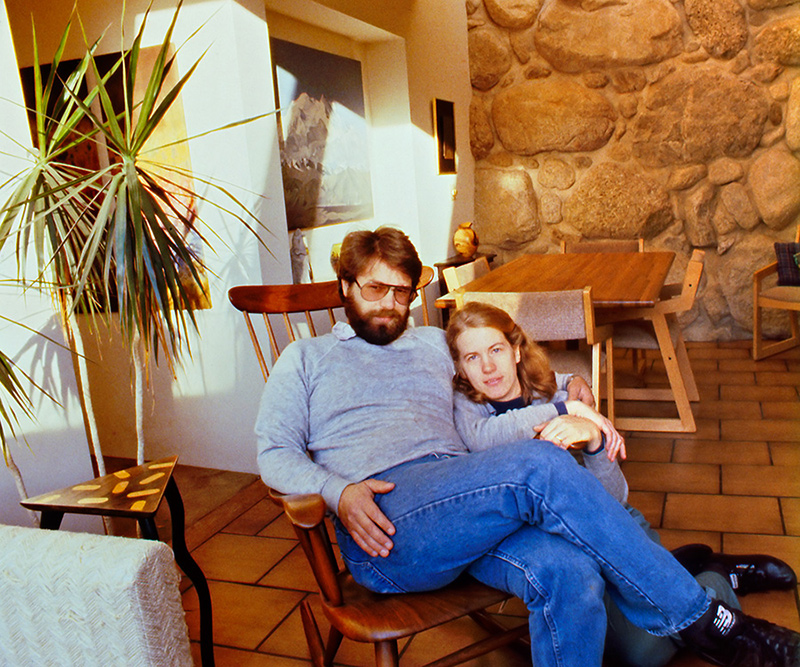
They built the house and studio, beginning in 1969, and continued to
develop the studio until 1986
when they sold the property, choosing to consolidate in Gadsden
County, Florida,
where they had established a studio space in 1983.
Photography was a requisite for documenting artwork, and Mark and
Kathy
shared a passion for photography. Photography become a concomitant
pursuit.
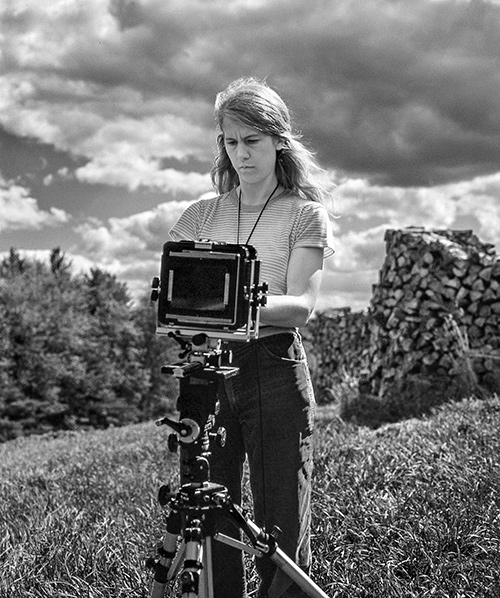
Kathy Lindquist studied photography with Ron Rosenstock (See R.
Rosenstock).
In addition to running Lindquist Studio, Kathy was responsible for
the Lindquist Studio darkroom,
producing archival fine art black and white prints.

Mark Lindquist, an avid camera enthusiast and photographer, studied
photography with Charles Sawyer
and Darr Collins at New England College. Mark earned a BA degree in
painting and sculpture,
involving special studies with painter Marilyn Frasca and
ceramist/photographer, Darr Collins.
He went on to study photography and ceramics at the Pratt Institute
MFA Program, Brooklyn, NY.

Mark Lindquist's photography professor Charles Sawyer (left) and
Ansel Adams (right)
Photo: Peggy Sealfon (copyright) Published by permission of Charles
Sawyer

Lindquist Studio, Henniker, NH. Studio on left, solar house on
right. The house and studio were built by
Mark Lindquist with the help of local craftsmen and tradesmen,
beginning in 1969 and continuing through 1985.
Lindquist Studio NH, circa 1983. The studio housed a special black
and white darkroom,
gallery, wood turning studios, office and library archives. Guest
rooms were on the top floor.
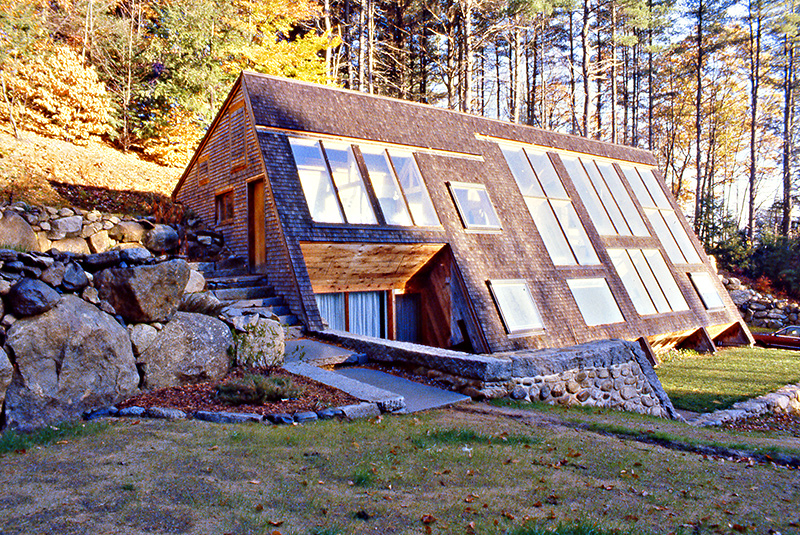
The solar house was collaboratively designed by Duncan McGowan,
Architect, and Mark Lindquist.
Originally, it served as a residence for the Lindquists’ parents,
but became part
of the New Hampshire studio complex once the Florida studio opened
in 1983.
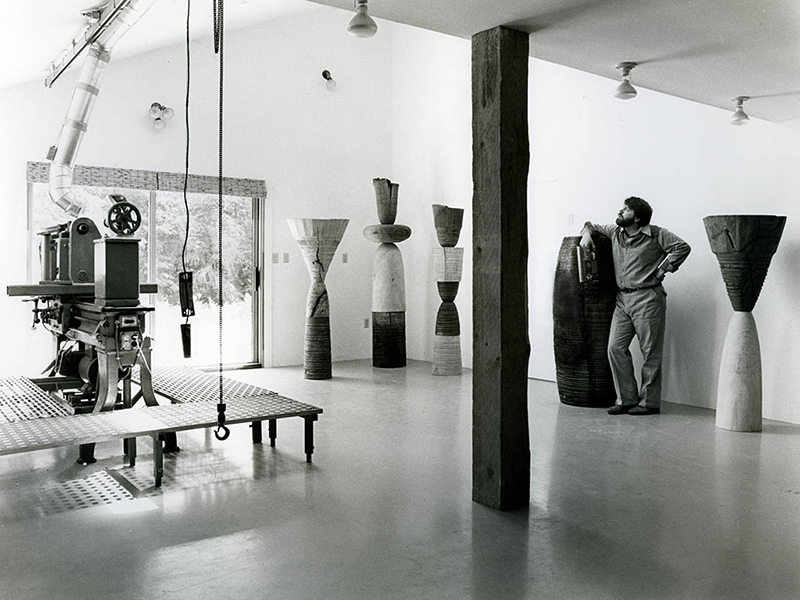
Interior, ground floor main studio, Henniker, NH. Mark Lindquist
began making large scale turned sculptures circa 1980.
Mark had a minimalist approach to working and brought only the tools
required for his current purpose into the main studio
so that in-progress work could be viewed as in a gallery.
The studio often doubled as a natural light photo studio since it
had a large skylight in the ceiling.
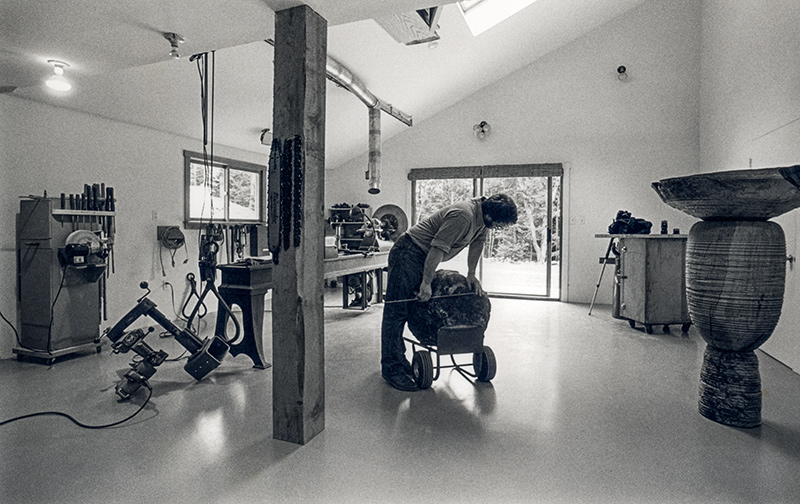
Mark began focusing on the vessel as sculpture after his work was
acquisitioned by the Metropolitan Museum of Art.
Once the Florida studio opened, his customized lathes were moved
seasonally between the studios.
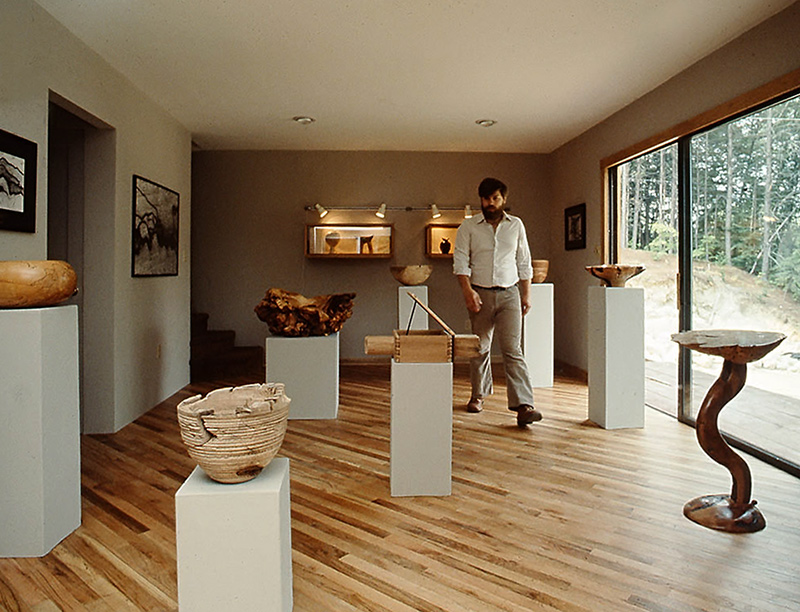
The upper floor, above the studio, held a gallery, office, and
archives.
Mark Lindquist in the gallery, with his Zone Line Series Photos, and
wood art.
Replication of the Resolute
Desk Project, Oval Office, White House, Washington, DC
Robert Whitley, Master Craftsman, asked Mark Lindquist to assist
him with a project to replicate
the Resolute Desk in the Oval Office of the White House. Lindquist
photographed, measured and made rubbings
of the details for Mr. Whitley who subsequently recreated the desk
for the JFK Memorial Library.
The two worked as a team photographing and analyzing the desk for
three days and two nights.
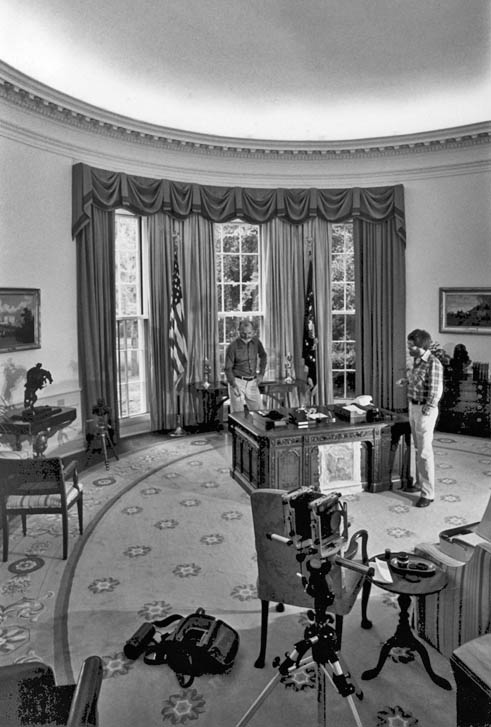
Robert Whitley (left), and Mark Lindquist (right), circa 1978, Oval
Office, White House, Washington, DC.
Photo (Copyright Lindquist Studios) by Mark Lindquist with his
Nikkormat on self timer.
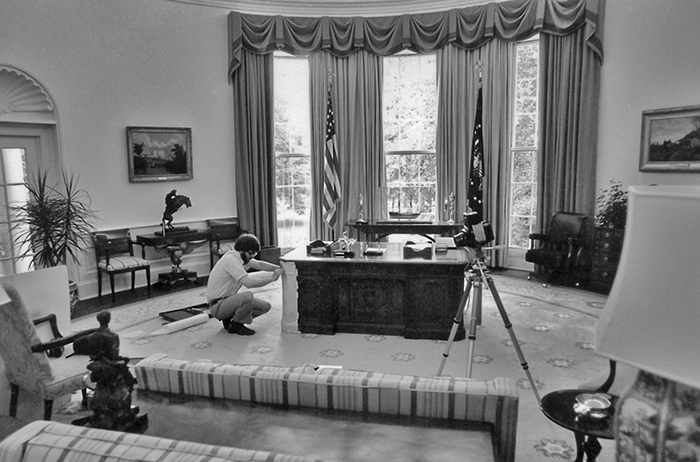
Mark Lindquist preparing to pattern a side panel of the Oval Office
Desk.
By rubbing a soft lead pencil over the rice paper, he transferred
the outlines of the carvings to the paper.
Robert Whitley, who received the commission, and Lindquist spent
three days and two nights
working in the Oval Office taking numerous photographs, rubbings and
measurements.
This was the first time the desk in the Oval Office was replicated.
The black and white photos were processed by Kathy Lindquist at
Lindquist Studios in New Hampshire.
Photo (Copyright Lindquist Studios) by Mark Lindquist using his
Nikkormat on self-timer.
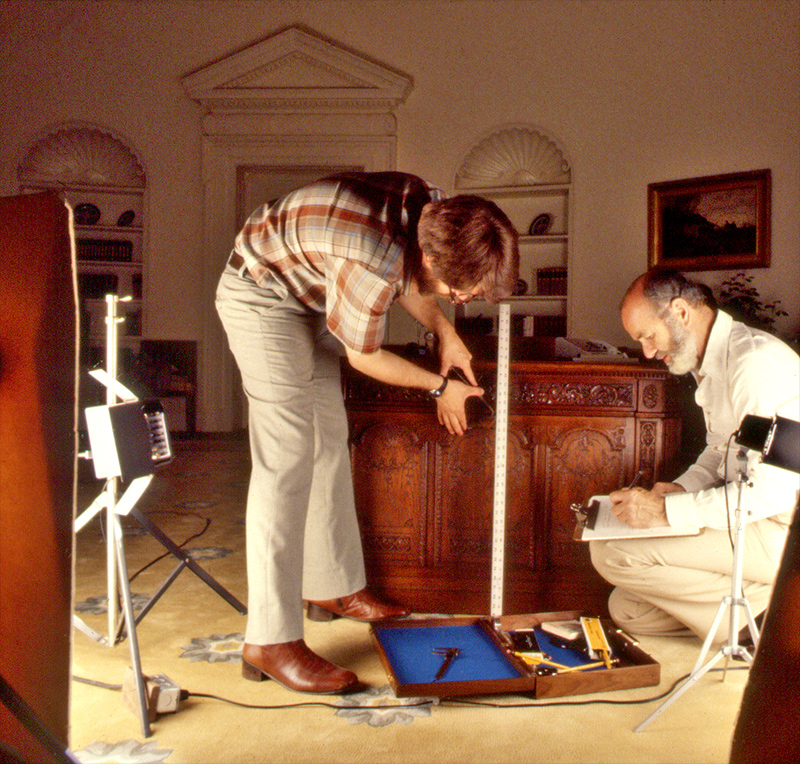
Lindquist, left, Whitley, right, working at night on the Resolute
Desk in the Oval Office of the White House.
The two worked three days and two nights, photographing, measuring
and patterning the desk, which was
subsequently replicated by Master Cratfsman, Robert Whitley for the JFK
Memorial Library.
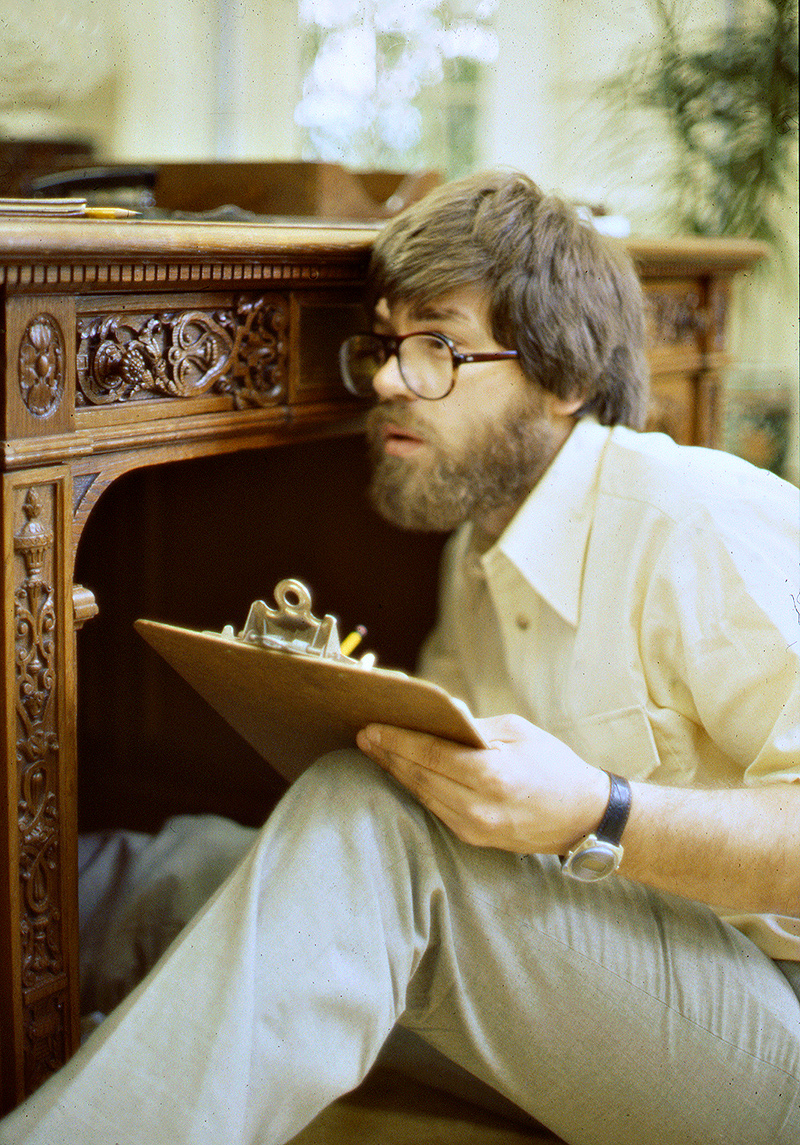
Mark Lindquist making a sketch of a drawer pull and carved panel for
the replication project.
"Working on the Resolute Desk with Robert Whitley was an honor
and one of the most challenging photographic projects
I have worked on. It involved intense concentration and the
application of many skills. Working with Bob was not easy;
he required exactitude and precision. I was thrilled to be involved,
and remember this project as a highlight
of my photographic career. Working together on this project was the
beginning of a long friendship
and ongoing sharing of ideas for Whitley and me."
John Gonser Movie, Micah
Productions, Switzerland.
In 1980, John Gonser came to the US and made a movie called "The
Good Life" that dealt with the subject of
Craftsmanship and Christianity in the US. Mark Lindquist was
chosen as a subject, and Gonser and his film
crew worked at Lindquist Studio for weeks shooting the film.
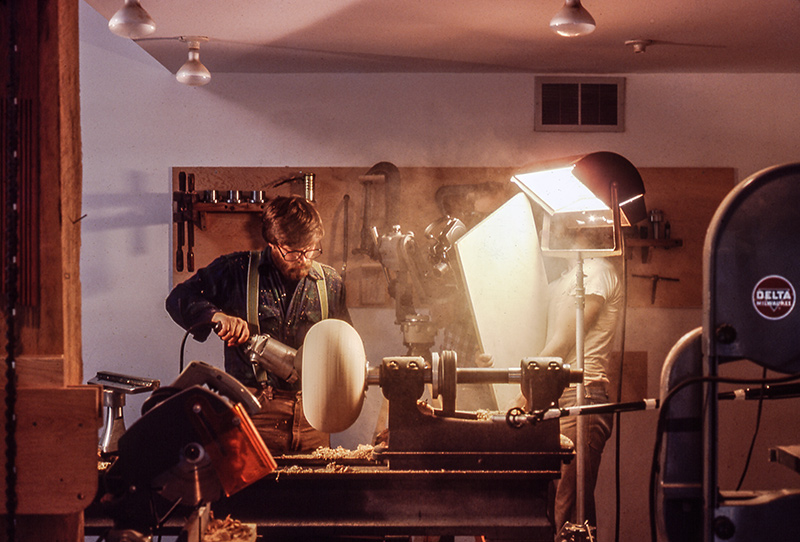
Mark Lindquist, turning a large bowl at Lindquist Studio during
the filming of Gonser's movie.
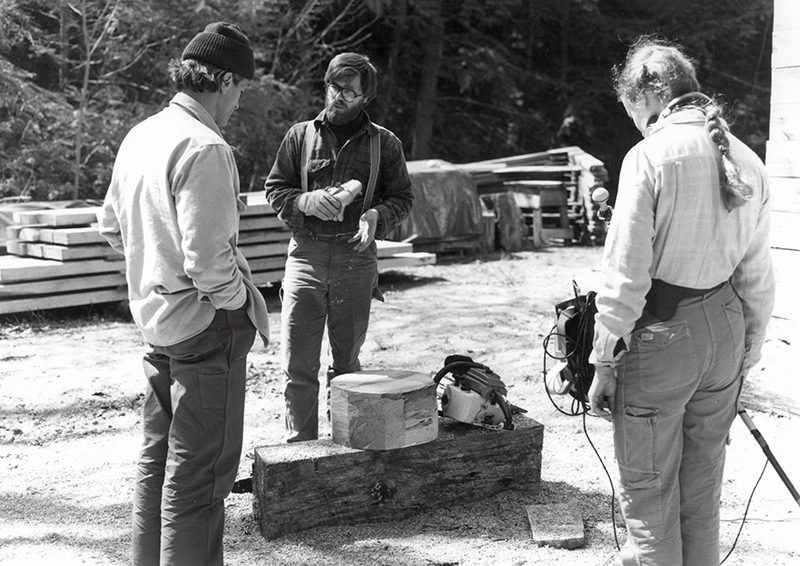
Lindquist and Gonser discussing a filming sequence that was just
shot.
The MacDowell experience, a
step in a new direction for Mark Lindquist
At the urging of NYC sculptor Will Horwitt, Mark Lindquist applied
for a residency and fellowship
at The MacDowell Colony in Peterborough, NH. The two month
residency afforded Mark time to reflect on his work
and to build an environmental sculpture The MacDowell
Woodpiles, which he created
on the MacDowell property by stacking forty cords of firewood into
sculpturally related forms.
The experience and the artwork would be life changing for Mark
Lindquist and Lindquist Studio
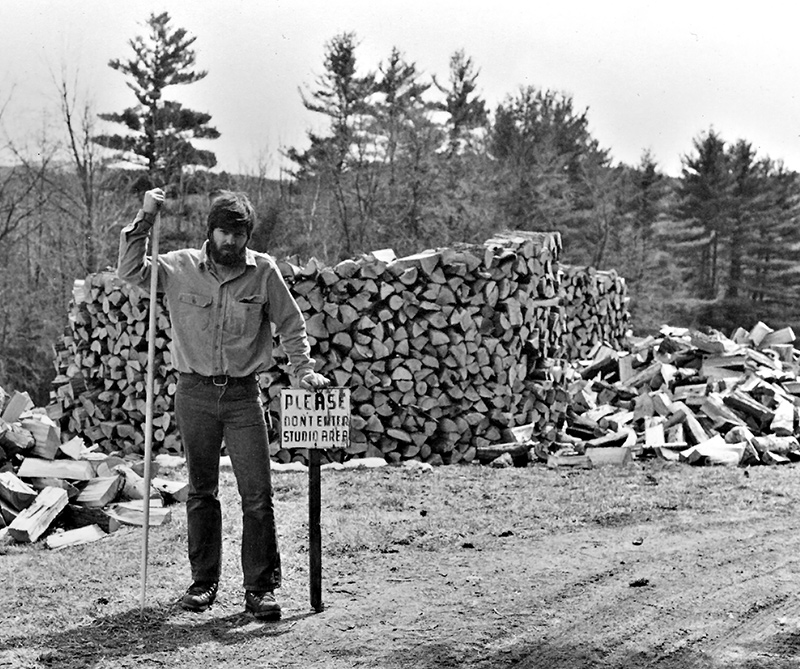
A MacDowell Colony rule states that no one can visit an artist
unless invited. Outdoor spaces sometimes
become studio spaces, as in the case of Lindquist’s woodpile
sculpture, so the Colony furnishes signs
to prevent passersby from interrupting an artist.
Writers, poets, and composers “coincidentally” jogged by
the developing sculpture, and Mark enlisted their help. Once he
managed to convince a writer
to spend an entire day helping to stack the logs.
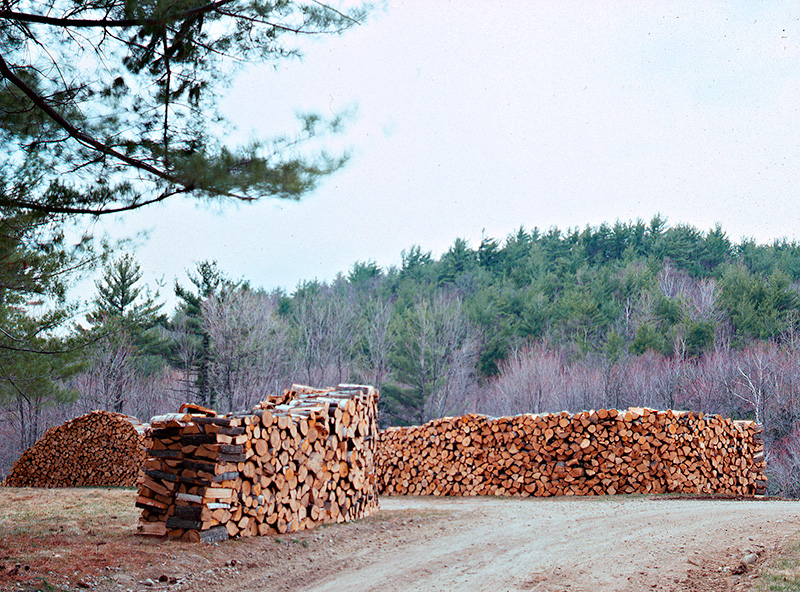
Side view of "Entry Gate" leading into the sculpture at MacDowell
Colony. While the sculpture was
being created during the early spring, no grass was growing, and it
was great "working weather"
to stack wood in. Forty cords is a lot of wood: a cord is 4 feet
high, 4 feet deep, and 8 feet long.
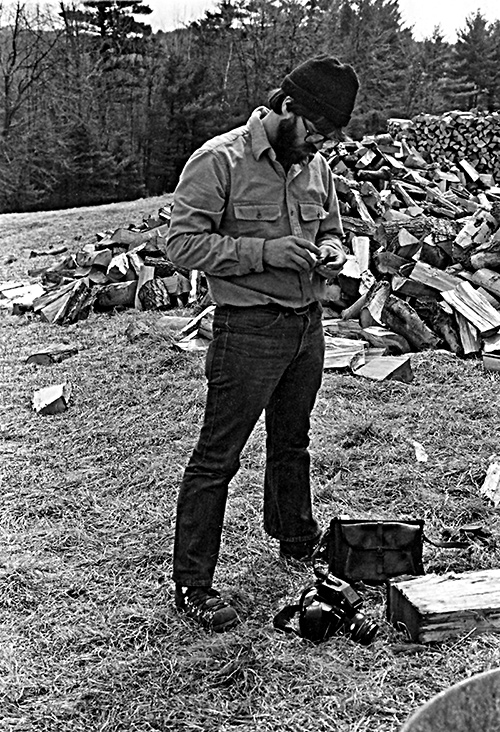
A major part of creating The MacDowell Woodpiles was photography.
Both Mark and Kathy Lindquist used 35mm, 2 1/4, and 4x5 cameras
during the
two month process. Here, Mark Lindquist loads his Mamiya M645 film
camera.
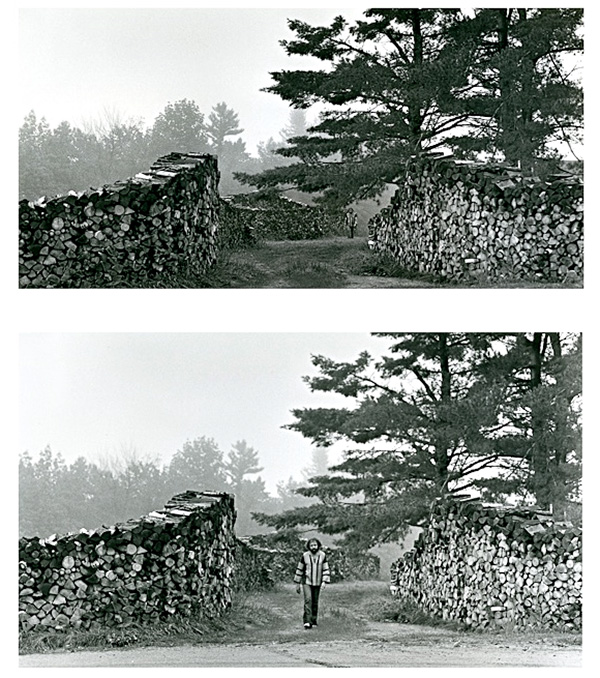
Will Horwitt, a close friend, visited the sculpture. Will had urged
Mark to become a MacDowell Fellow
and was pleased to see the work. Will Horwitt was a Guggenheim
Fellow.
Lindquist Studio, Gadsden County, FL
In 1983, Mark Lindquist began looking for a southern studio
possibility. He was living in Atlanta, Georgia,
during the winter and scouting potential sites. A student and
friend, Terry Kori, introduced Mark to
Gadsden County, Florida. When Mark saw this "compound" of
brick packing house, wooden manufacturing annex
and tobacco barn, it became a marriage made in heaven. The property
was purchased from William G. Crawford Co.
and Lindquist added additional acreage until at the height there
were 50 acres. Subsequently, some acreage
was sold off as people began to develop the surrounding land.
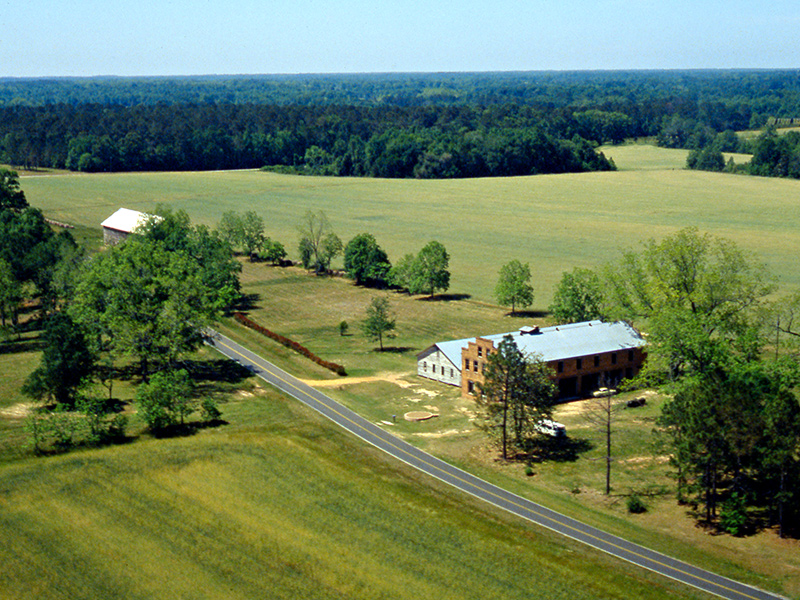
Aerial view of Lindquist Studio, Gadsden County, Florida, circa 1984.
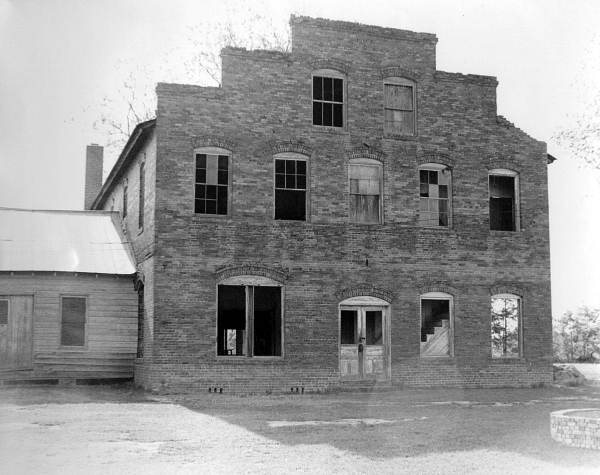
Lindquist Studios Main Studio Building (right) after cleanup, prior
to renovations - 1983.
State Archives of Florida, Florida Memory, http://floridamemory.com/items/show/3300
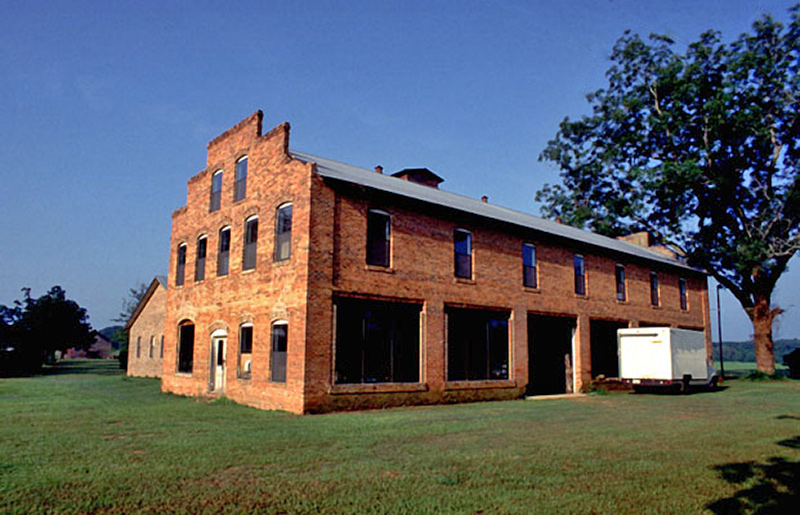
Lindquist Studio, FL, circa 1987.
The tobacco packing house, where once workers graded and sorted,
then packed shade leaf tobacco for rolling
cigars, ultimately became Lindquist Studio, where the Lindquist
family created decades of artwork. Much of the
packing house has been rebuilt or refurbished, and is an ongoing
project still.

Street side view of Lindquist Studio, Gadsden County, FL circa 1995
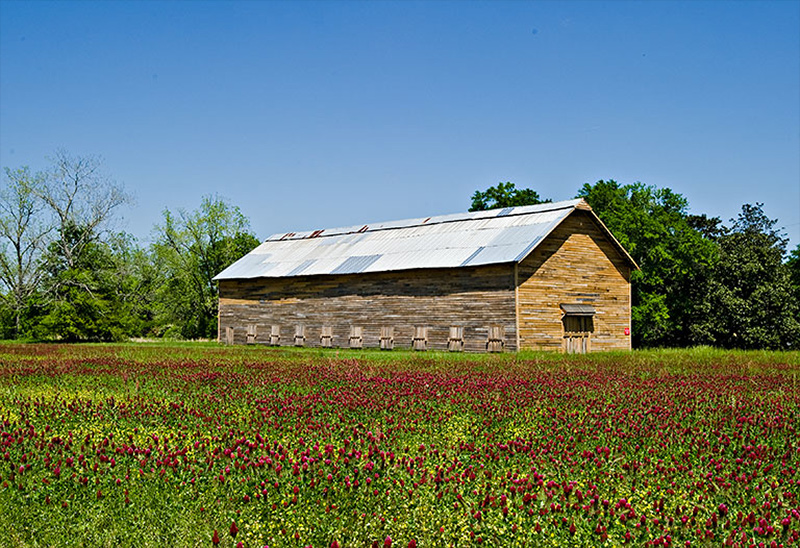
The Lindquist Studio Shade Leaf Tobacco Barn, Gadsden County, FL.
One of 24 tobacco barns left on the 500 acre tobacco plantation, 50
acres of which became the site of
Lindquist Studio, FL.
Farmers grew shade leaf tobacco (or shade tobacco) in Gadsden
County, Florida.
They used Mules to work the soil under shade canopies, which enabled
the tobacco to grow
protected from direct sunlight (See below).
The shade tobacco leaves were hung in the barns and were "fired"
(barns were heated)
to dry the leaves quickly and thoroughly for making cigars.
Mark Lindquist began storing wood and burls in the barn beginning in
1984
The barn was resided in 2007 with cypress boards from a Georgia sawmill.

Plowing under the shade with mules - 1939 Photo
State Archives of Florida, Florida Memory, http://floridamemory.com/items/show/151856
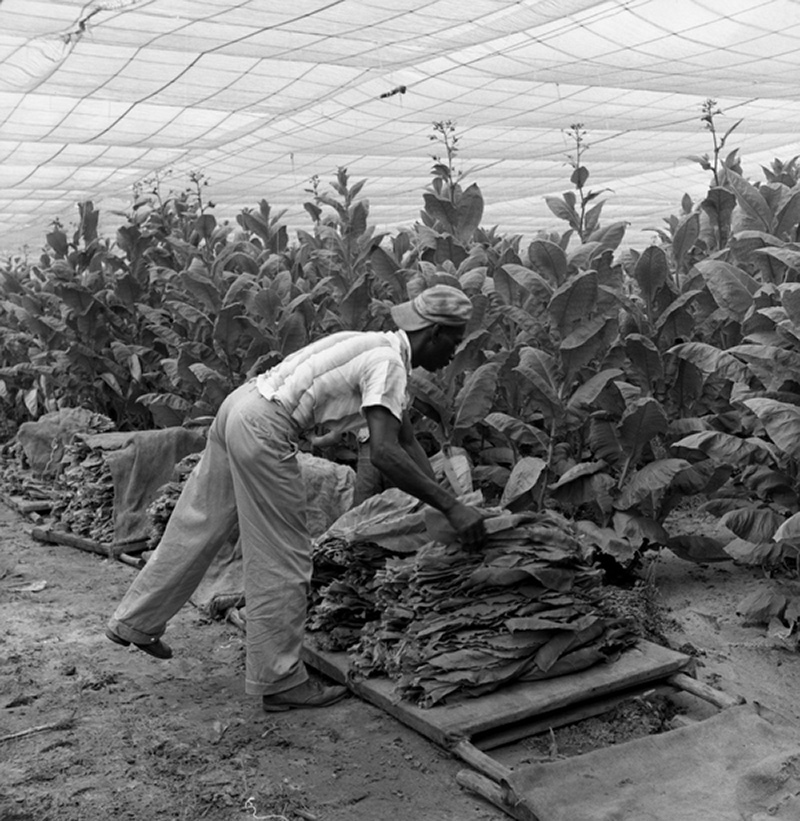
Worker harvesting shade tobacco for the Florida Cigar Company in
Quincy, Florida circa 1959
"The tobacco crop is never in the sun. Cheesecloth shields the
growing plants from the direct rays of the sun.
The crop is harvested in the shade and carried to the drying barns
in covered wagons."
Image from the State Library and Archives of Florida
http://floridamemory.com/items/show/262413
Read about Cigar making in Gadsden Florida here:
Lindquist Studio - Front Studio
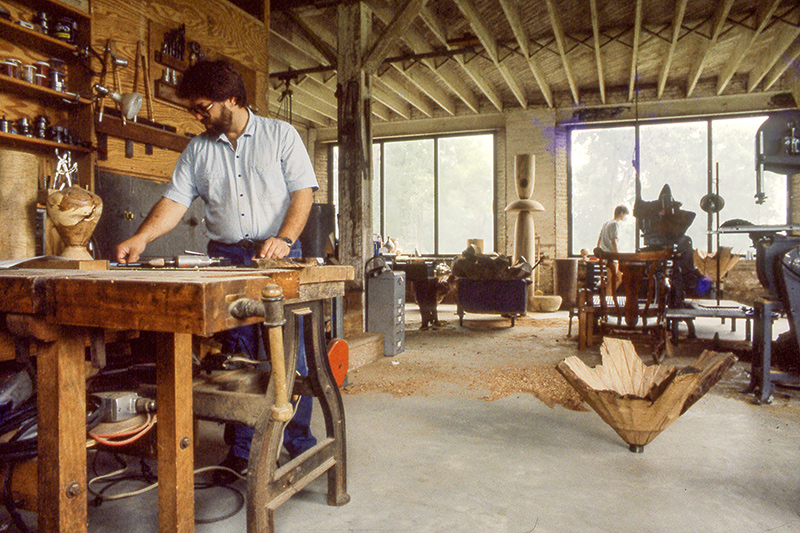
An early photo of Mark Lindquist, with son Ben Lindquist in
background, working in the Front Studio.
The front studio underwent many iterations, changing shape as
needed.
Sometimes it was used for woodturning - sometimes it was used as a
photo studio, machine shop, or wood shop.
The studio window walls faced north for grading and sorting tobacco
leaves.
Mark installed 8 foot by 8 foot industrial sliding glass doors which
created perfect light for Lindquist Studio.
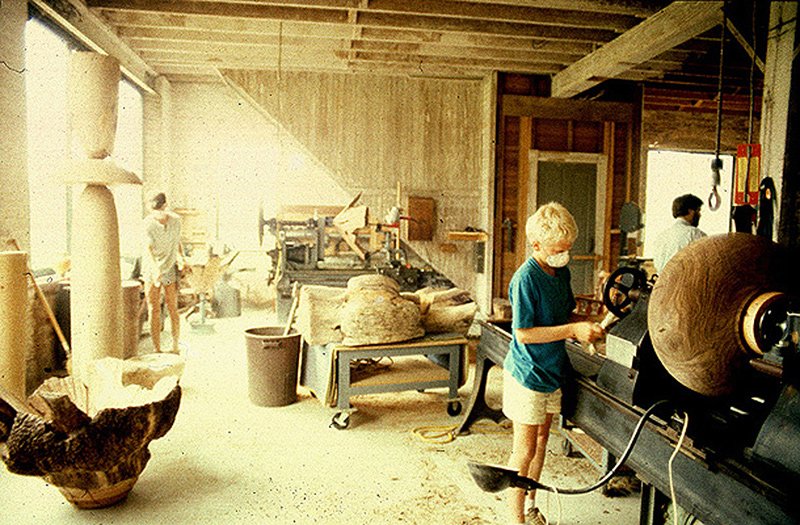
The Lindquists’ sons, Ben (left) and Josh (center) frequently helped
with cleaning the studio. Circa 1988.
Considering the size of the pieces being made, the sawdust could
become difficult to deal with.
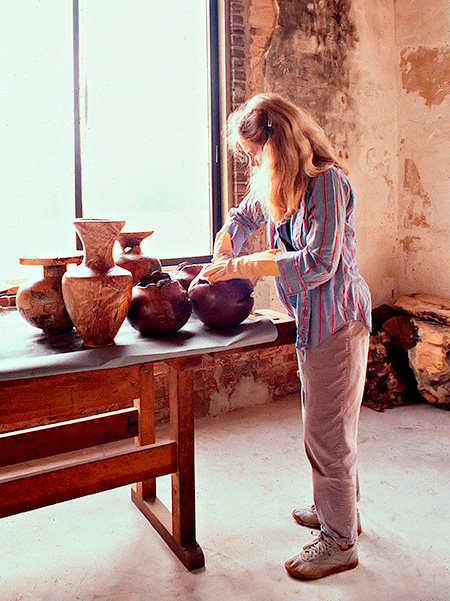
Kathy Lindquist applying finish to Mel Lindquist's pieces, circa
1985, in Lindquist Studio "Front Studio"
Kathy was a miracle worker with certain finishes and she did almost
all of the final finishing
on Mel Lindquist's pieces. Mark generally finish-sanded them, since
Mel's eyesight was failing,
and Kathy applied the oil finishes. The Lindquist finishes were
known as the best in the field at the time.
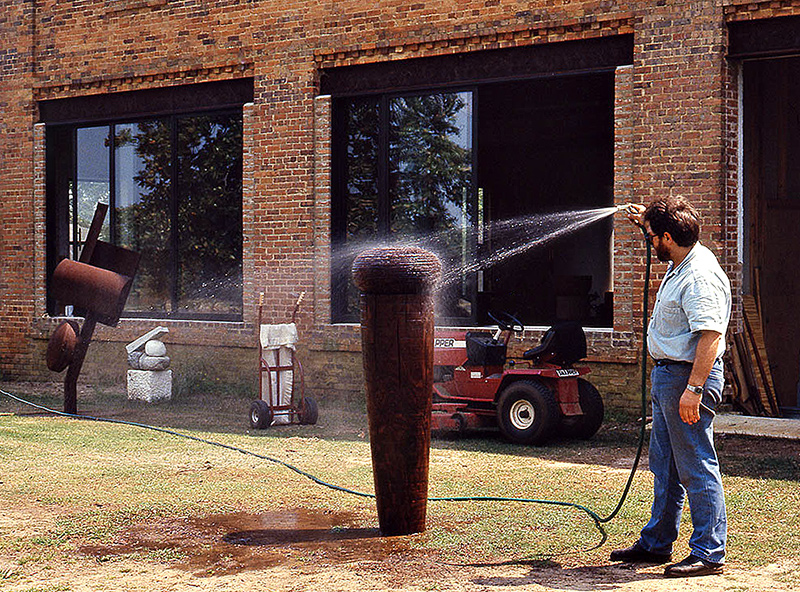
The Florida Studio, (Lindquist Studio) offered Mark unparalleled
access to outdoor workspace during
the winter. Here, Mark is spraying water on a newly turned
sculpture made from walnut.
The water helped to slow the drying of the wood, and exposure
to
sunlight gave the pieces and exquisite patina.
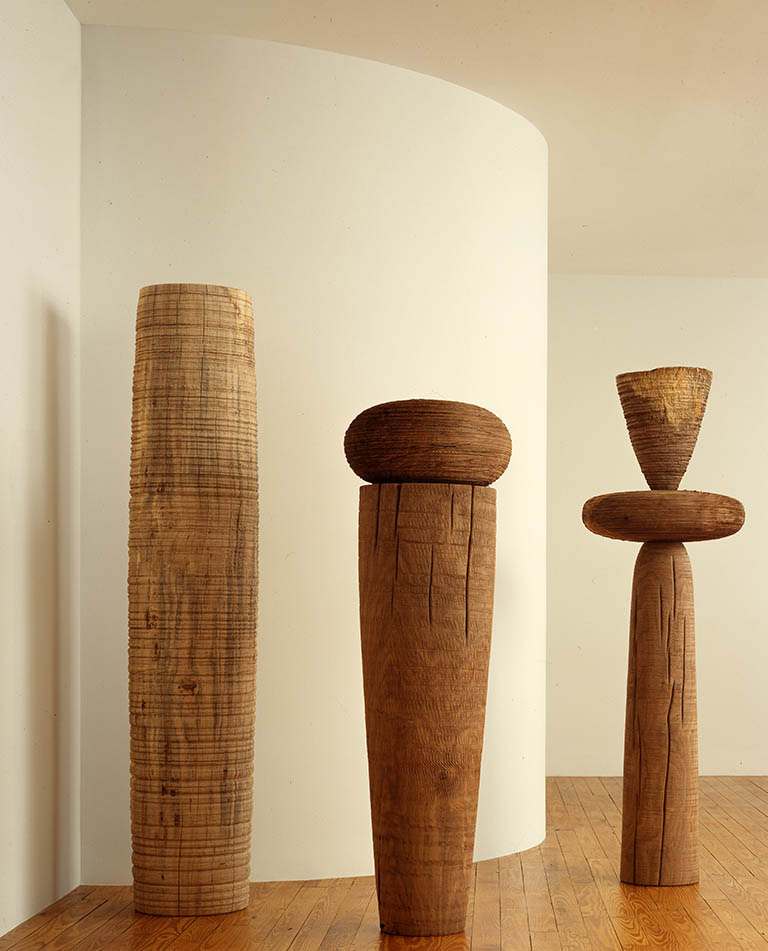
Works made in Lindquist Studio, FL. Lindquist's Totemic Series
pieces displayed in the first Lindquist Studio FL gallery.
The Wreck. A new era
for Mark Lindquist and Lindquist Studio
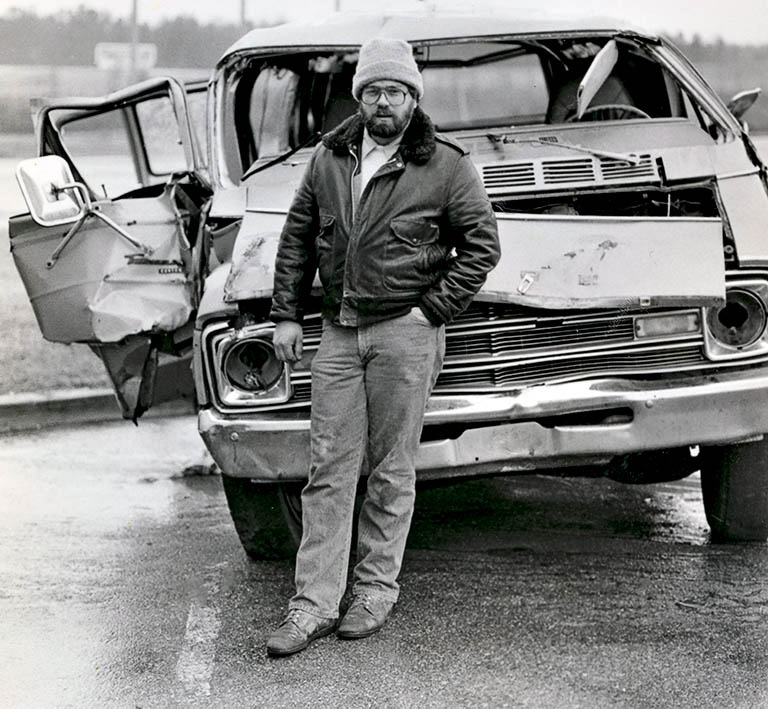
In 1986, Mark Lindquist suffered a near fatal automobile accident.
He was traveling to the ACC
Baltimore Winter Market, riding in the back of the van, asleep, on
top of boxes of artwork when
the studio assistant who was driving fell asleep at the wheel,
veered off the highway hitting a mile marker.
The driver awakened, attempted to correct and the van flipped over
and over down an embankment traveling 70 mph.
The crash occurred in the median of a weigh station in Georgia. The
van had flipped 5-7 times and landed upside down.
Luckily, many saw the accident happen and Lindquist was quickly cut
out of the vehicle with the Jaws of Life by EMTs.
Miraculously, Lindquist was still alive, and underwent subsequent
surgeries.
Unfortunately, he suffered head trauma and dealt with intractable
daily migraines for 20 years.
Thankfully, the migraines have diminished and Mark is enjoying life
more, mostly migraine free.
"I'm lucky to be alive. Life is never the same after head trauma.
You can put a broken glass back together,
but it doesn't necessarily hold water the way it was meant to. I
relive the accident less frequently now,
than years ago. The headaches come and go. There is life before an
accident, then life after an accident.
Wonderful things still happen in life, yet they are perceived
differently, as though through a photographic filter
that you can't get rid of. Head trauma is difficult to live with.
Life goes on, yet one is changed, but to most,
appears the same on the outside. On the inside looking out, the
world is a changed place.
Ultimately, one figures out how to do things differently, to
compensate, just as the brain does, from right to left."
The Back Studio, Lindquist Studio, Florida, and robotics.
After the accident, Mark realized he couldn't use the work methods
he had been employing prior to the accident.
He began building robotic "helpers," which enabled him to sit in a
chair or would multiply the force
for him. Just as he had been always interested in a certain type of
mechanics as a child, he reverted, post-accident,
to becoming a "gadgeteer," creating machines for holding and
positioning work, and for applying linear motion.
Ultimately, his robotics would influence his photography in addition
to his wood sculpture.
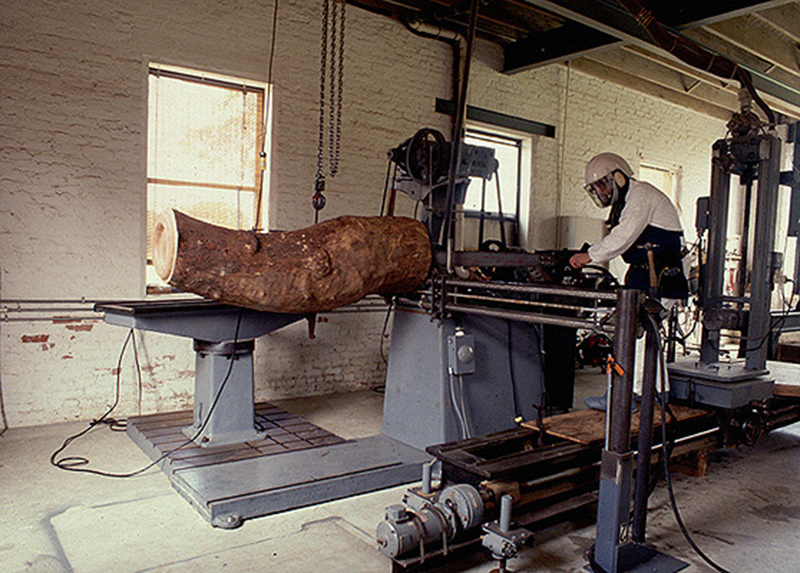
Lindquist Studio, Back Studio, Quincy, FL -
circa 1995
Mark Lindquist with his patternmaker's lathe and his robot ASTRO
(Assigned Specific Task Robotic Operative
[extreme right], designed and built by Mark Lindquist). Lindquist
uses protective suit and breathing apparatus
while working to minimize exposure to dust and fumes during the
chain sawing process.
Renwick Gallery 25 Year Retrospective Exhibition, Smithsonian
American Art Museum, Washington, DC.
Mark Lindquist: Revolutions in Wood (1995), twenty-five year
retrospective curated by Robert Hobbs,
opens at the Renwick Gallery of the Smithsonian Institution and is
exhibited through July 1996.
"This period of intense growth and discovery was capped off by
the retrospective of Mark Lindquist's work in 1995,
probably the first single artist retrospective for the second
generation of wood artists.
Accompanied by an attractive, substantive catalogue with numerous
color illustrations and an essay
tracing Lindquist's creative story in the context of modern
sculpture, it set the bar for other single-artist
shows to come for the next 15 years. The bar had clearly been
raised for wood artists, too."
Jennifer Komar Olivarez, Curator of Decorative Arts and Design,
Minneapolis Art Institute
From: “Wood Art’s Rise to Fame: Developments to
1996,”
in Conversations with Wood: The Collection of Ruth and David
Waterbury
(The Minneapolis Institute of Arts, 2011), pp. 25-31.
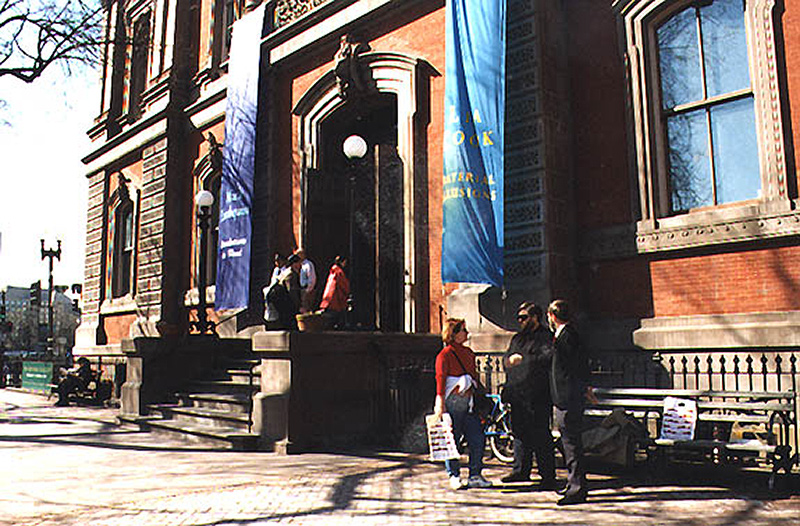
Mark Lindquist (center) and Studio Assistant Roger Paph (right),
discussing Lindquist's 25 year retrospective
exhibition with a collector in the front of the James Renwick
building, located across from the White House
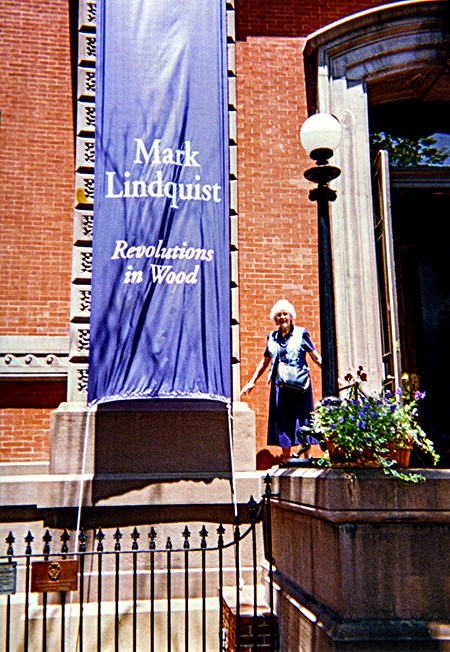
Ms. Julia Munroe Woodward, a staunch supporter of the arts in
Gadsden County, Florida,
traveled to Washington and posed next to the 40' banner
advertising the exhibition
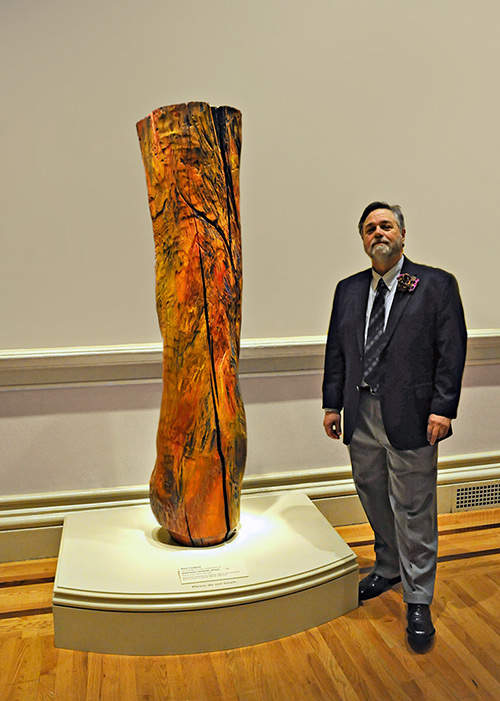
Mark Lindquist, with
Akikonomu, in the Renwick Gallery, Smithsonian American
Art Museum.
Akikonomu was accessioned by the Smithsonian American
Art Museum in 2005.
Lindquist Studio, Gadsden
County, FL, spaces.
From the beginning, Lindquist Studio has had a philosophy based on
the Japanese concept
called "changeable use", whereby one room may have many different
functions at different times.
Lindquist Studio has many spaces, for living, working, meeting,
showing artwork, and conserving archival objects.
Although Lindquist Studio is 15,000 square feet, and an additional
10,000 square feet of the barn,
there is often not enough room for certain projects. Any space
may be called upon to morph, or do double duty.
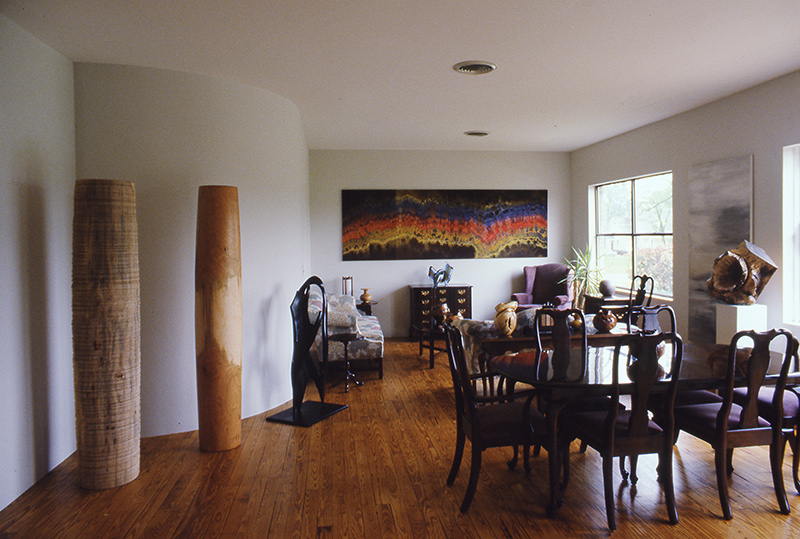
Lindquist Studio living, meeting, exhibiting space, ground floor,
circa 1987.

Mark Lindquist discusses his work during the filming of a movie -
Blakely Burl Tree Project.
The gallery houses artwork from several disciplines.
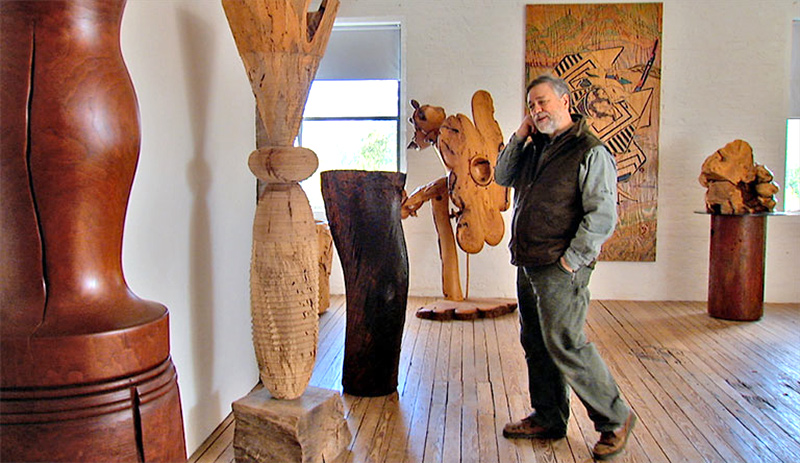
Lindquist Studio Gallery, essentially a New York City loft in farm
country setting.
Mark Lindquist discusses his work during the filming of the Blakely
Burl Tree Project.
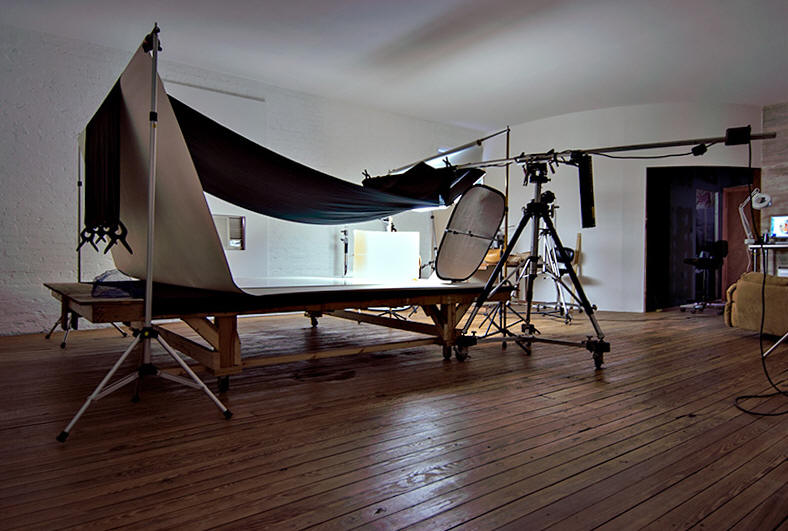
Lindquist Studio, second floor photo studio, varies depending on
photographic requirements.
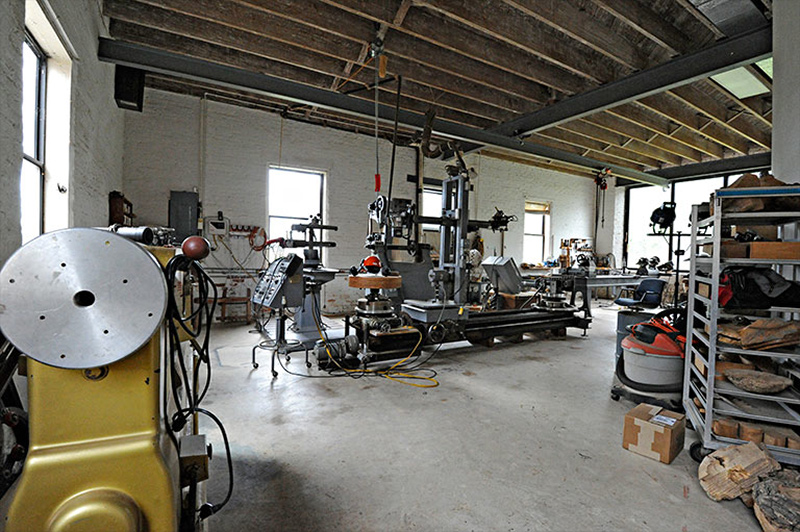
Lindquist Studio, FL - "The Back Studio"
Renovated to include metal I-beams for hoisting large logs and
finished sculptures.
The Back Studio is where Mark spends most of his time making wood
art. The machines
have been retrofitted, with robotic controls, and Lindquist built
several robots to enable safe
working practices. Additionally, the robots are employed in
the making of his
motion blur abstract photography. This studio is furnished
with computer and sound system.
Mark Lindquist Photographer
- Lindquist Studio
Since the beginning of Lindquist Studio, Mark Lindquist has
concomitantly photographed,
his and other artists’ work. From the beginning, Lindquist has had a
keen interest in the
development of his photographs as art. Once film photography began
to wane,
Mark began working seriously in the realm of digital photography and
use of the Studio’s
film equipment (35mm, 2 1/4, 4x5) began to dwindle.
Mark has been a Photoshop user beginning with Adobe Photoshop 1.0
(1990).
Photoshop provided a way to manipulate film images, in the "Digital
Darkroom."
Mark’s initial digital cameras were the Polaroid PDC 1,000 and 2,000
and the first
Minolta DSLR. The second DSLR was a Canon 10D that was modified to
accept Nikon Lenses.
Soon, Mark was able to come back to shooting Nikon cameras using his
original lenses,
beginning with the Nikon D2H, the Nikon D2X, the Nikon D3s, and
currently the Nikon D810,
all of which Mark still has and uses to this day.
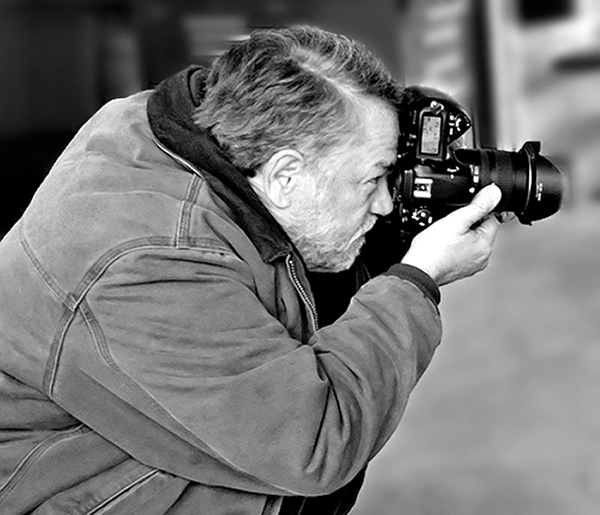
Mark Lindquist, shooting the Nikon D3s during the Blakely Burl Tree
Project.
Much of Lindquist Studio's photography is project oriented.
Mark Lindquist has participated in numerous
projects over the years, in addition to his own fine art
photography.
Below are a few examples of various projects Mark has been involved
in.
Bricks and Burls
Mark Lindquist at the School of Architecture, Florida A&M
University, Tallahassee, Florida,
with his environmental sculpture installation, "Bricks and Burls."
The installation, on two levels of courtyards and walkways that link
the school together,
included 10,000 bricks and over 100 burls. Lindquist created the
installation
with the help of the School of Architecture students.
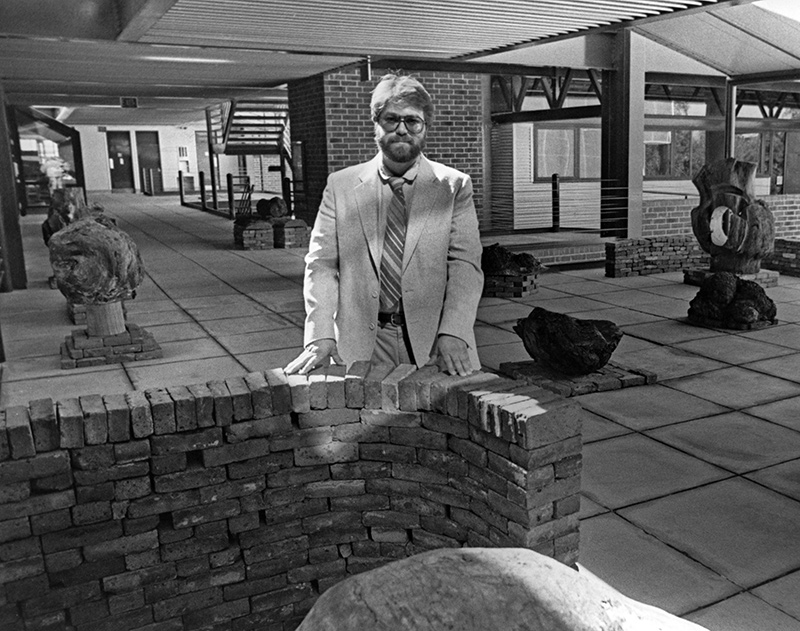
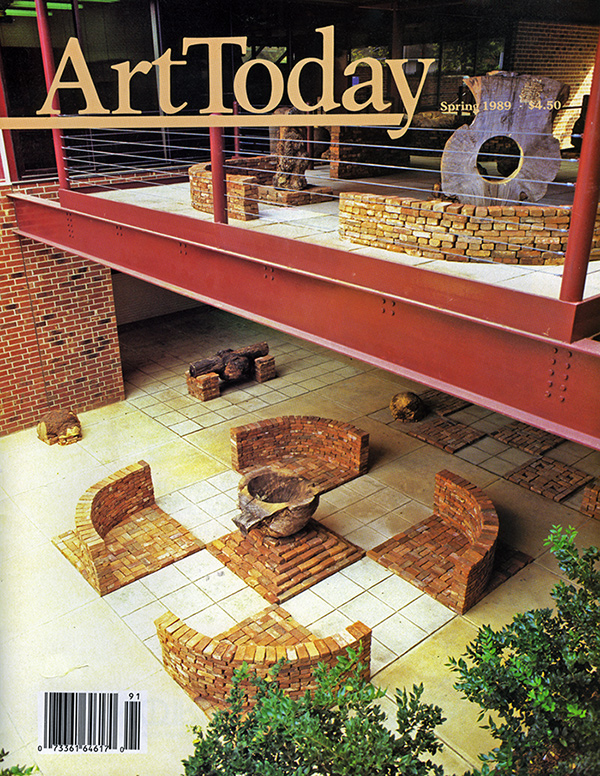
Technical photography - photo illustration
In 1993, the renowned scholar Penelope Mason, while writing her
History of Japanese Art, requested
permission from a rival publisher in Japan to use rare photos of the
process called “cord marking,”
which was used in the making of Jomon pots.
Permission was denied and Professor Mason came to Mark Lindquist for
help.
Applying his background in pottery, he was able to come up with a
system to replicate the markings.
He photographed the results, which were published in her book.
Mason’s History of Japanese Art was the first volume in thirty years
to present a detailed
explanation of the subject, and it remains the only comprehensive
survey of its kind in English,
according to the publisher, Abrams.
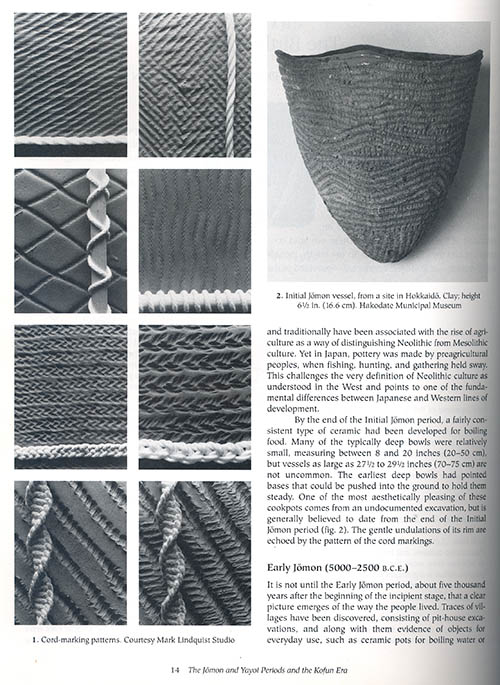
Mark Lindquist illustrates the techniques used for
producing cord markings in Jomon pottery.
The page shows Lindquist's photos (copyright Lindquist Studio) in
the book:
History of Japanese Art, by Penelope Mason.
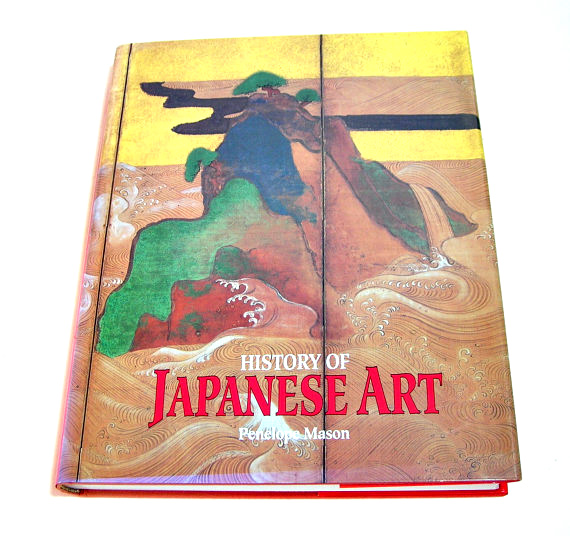
Precious Metals Photography
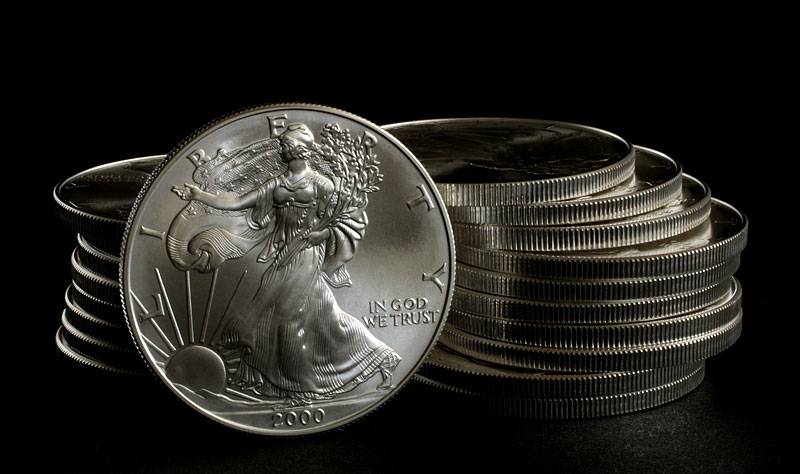
In 1999, Lindquist took on a client who became one of the most
distinguished precious metals dealers
in the country. Lindquist was commissioned to photograph precious
metals coins and historical bullion.
Developing techniques for shooting in natural light, many of his
images are in use today,
illustrating gold and silver bullion and historical collector coins.
Design and Project
facilitation
ICONS: A Tribute to Melvin Lindquist
Mark Lindquist was the project facilitator, photographer, and artist
participant in the ICONS Project
He designed the exposition booth, and was responsible for the
photography for the catalogue.
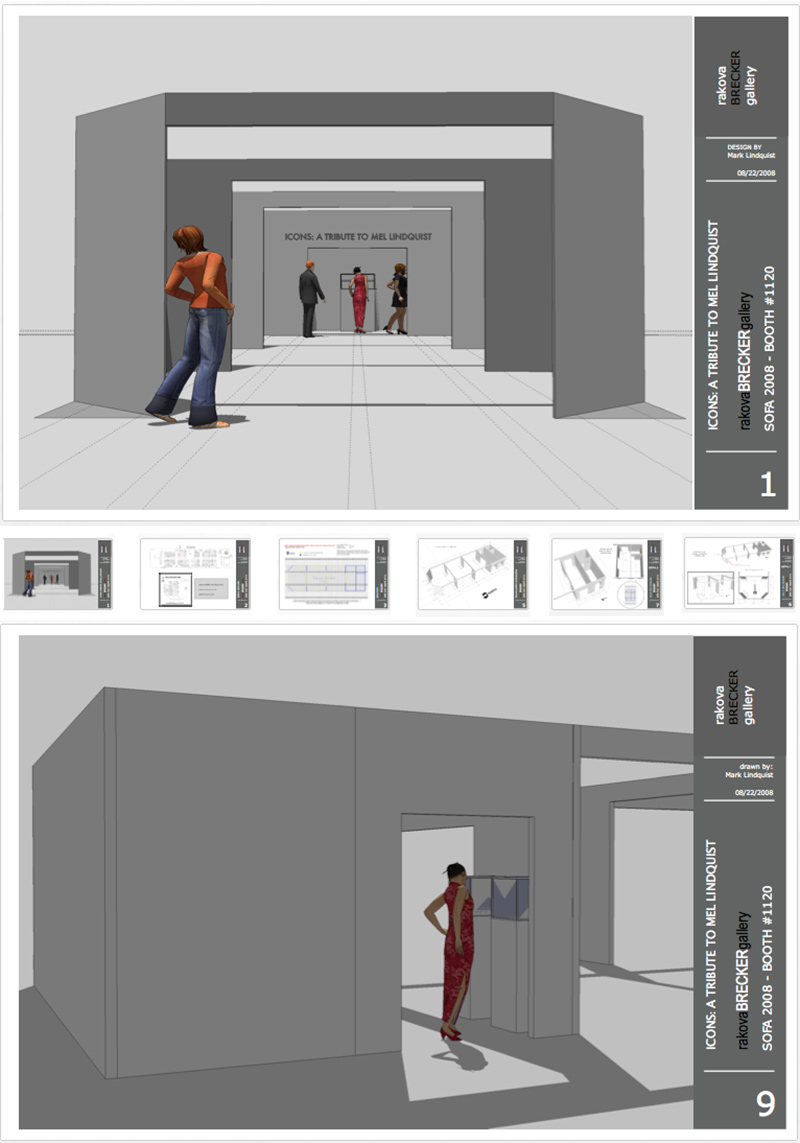
Booth Design, ICONS Exhibit, SOFA Chicago
For RakovaBrecker Gallery by Mark Lindquist, Lindquist Studio
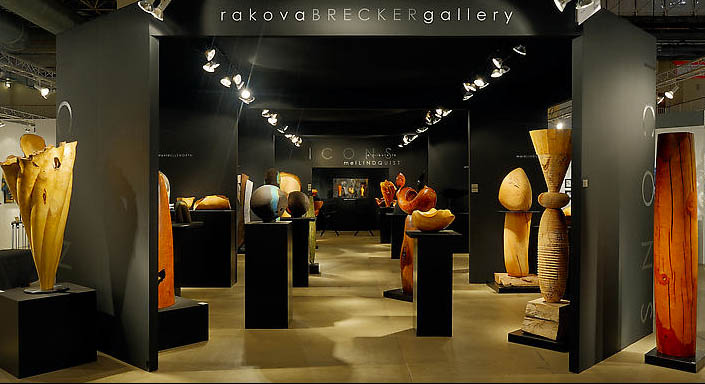
Final booth install with artist's works, SOFA Chicago.
Photo: J. McFadden

Booth setup just prior to main opening |
Photo: J. McFadden
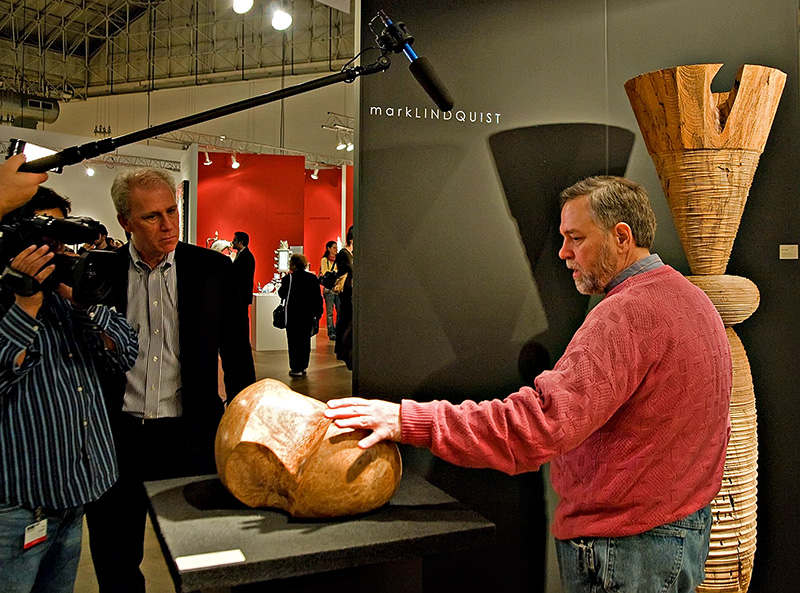
Ken Browne of Ken Browne Productions, NYC, (center)
filming Mark Lindquist during the exhibit at SOFA Chicago.
Photo: J. McFadden
ICONS: A Tribute To Mel Lindquist - Photography Project
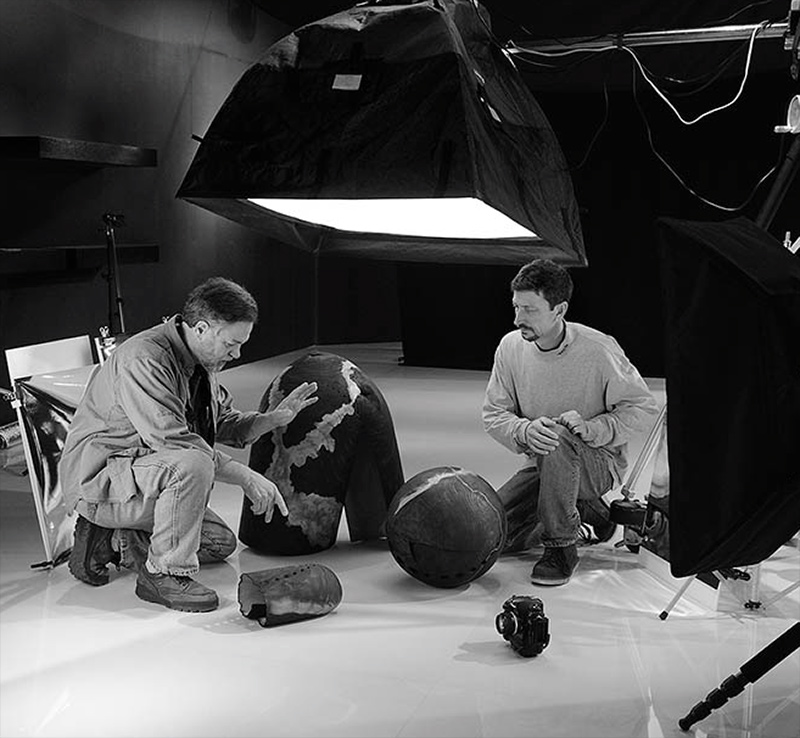
Mark Lindquist (left) with former Lindquist Studio assistant John
McFadden working on images for the catalog:
ICONS: A Tribute To Melvin Lindquist
Lindquist and McFadden temporarily repurposed the Rakova Brecher
Gallery in order to do the shoot.
The two worked 3 weeks shooting in Ft. Lauderdale, FL, then 3 weeks
editing at Lindquist Studio.
The catalog was subsequently published in Hong Kong, and the
exhibition was held at
SOFA chicago, where it was well received by all.
ICONS from LucieHall on Vimeo.
The Blakely Burl Tree
Project
In 2009, Mark Lindquist became the Project Director of the Blakely
Burl Tree Project.
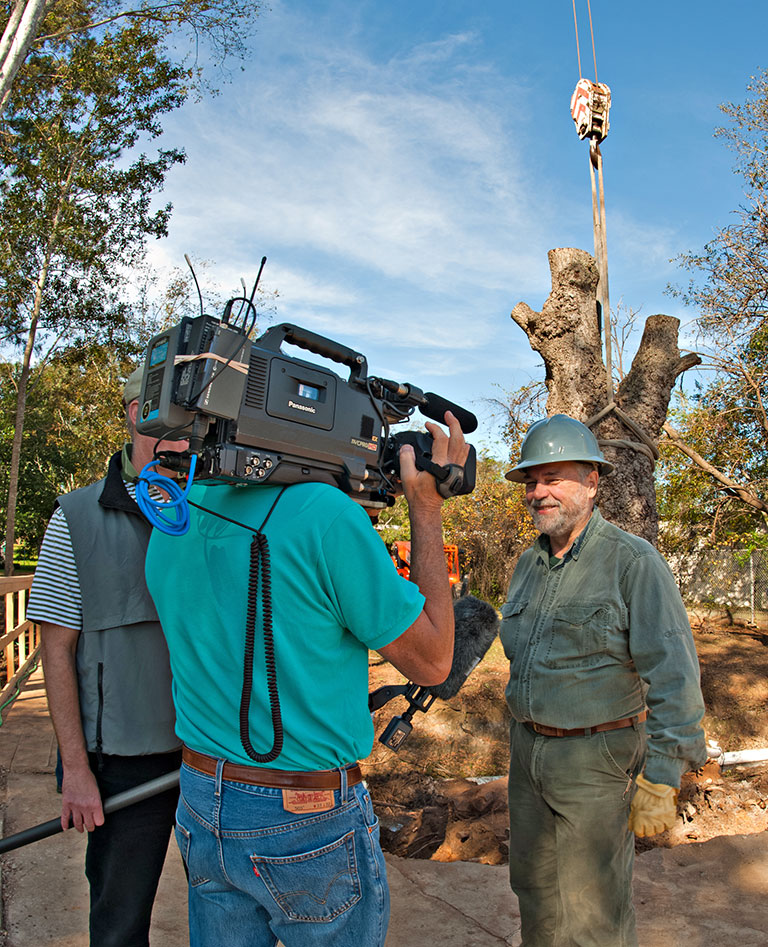
The Blakely Burl Tree Project was sponsored by the Charles
and Catherine B. Rice Foundation
of Atlanta, GA. As a building was torn down in Blakely,GA, a
pecan burl tree was revealed.
Mark Lindquist was contacted to become the project manager to
excavate the tree and
document the process. People were flown in from all over the
United States and Australia
to work on the project. Lindquist not only directed but also
photographed the project
along with others including Gregory Andracke, Ken Browne, John
McFadden, and Terry Martin.
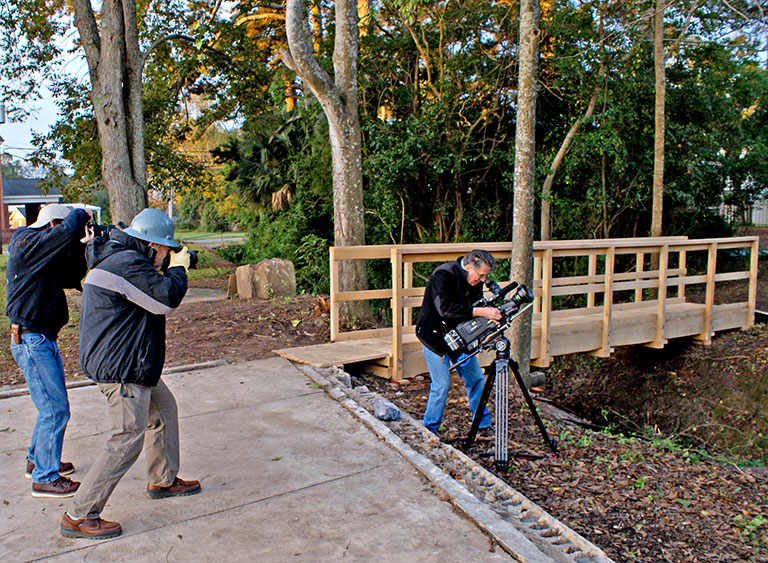
Mark Lindquist, foreground left, photographing the burl tree during
the morning's glory light.
Much photography of the tree was done before excavating it for
the project.
Photos: John McFadden, Terry
Martin
Gadsden Arts Center
For many years Mark Lindquist has been involved with the Gadsden
Arts Center where a 40 year
retrospective of his work was held. Lindquist Studio has been
actively involved with GAC since the
early eighties. Gadsden Arts Center is a local arts
organization in Gadsden County, Florida.
The photos below show some of the work that was on display
during Lindquist's
40 year Retrospective exhibition at GAC.
Photos: Mark Lindquist, and John
McFadden,
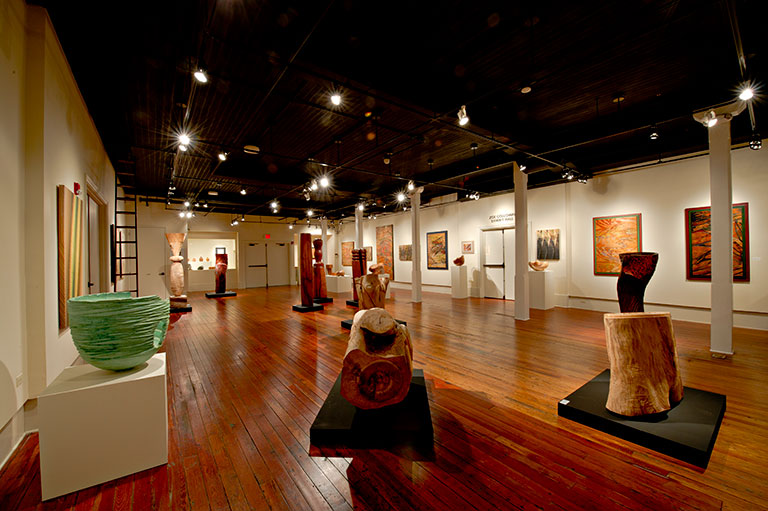
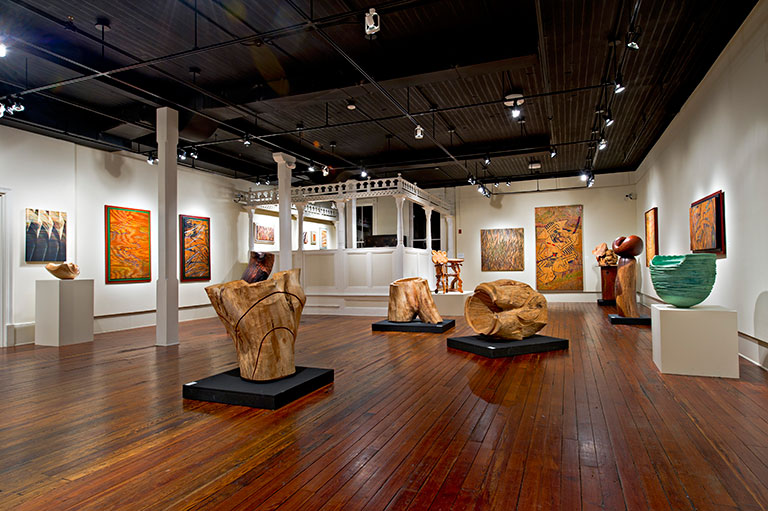
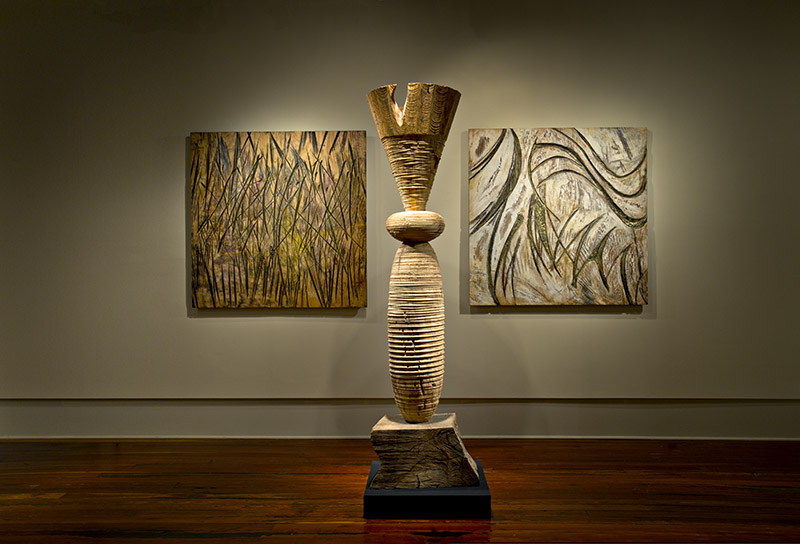

The above photos illustrate some of the work that was on display
during Lindquist's 40 year Restrospective exhibition.
Photos: Mark Lindquist, and John
McFadden,
Wine Cabinet
Mark Lindquist does special product photography, such as this wine
chest he designed,
with landscape sculpture. Chris Smith built the casework and
drawer.
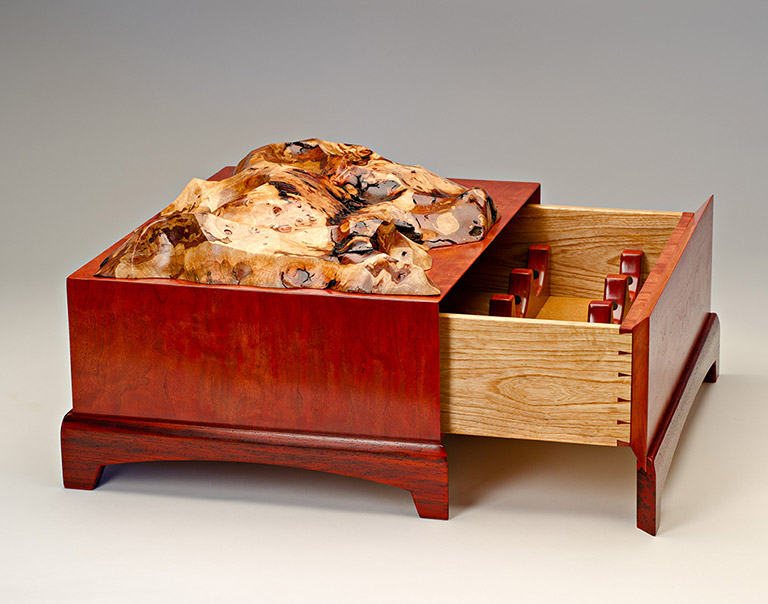
Photo: Mark Lindquist, Lindquist Studio
The Dowel Bowl
A work of art created by Mark Lindquist for a special project begun
by Ethan Lasser,
Harvard Art Museums’ Margaret S. Winthrop Associate Curator of
American Art., when he was curator
of the Chipstone Foundation, Milwaukee, WI. The piece was
shown at the Milwaukee Museum of Art,
and traveled throughout the US. Lindquist's photo, below, was
extensively published.
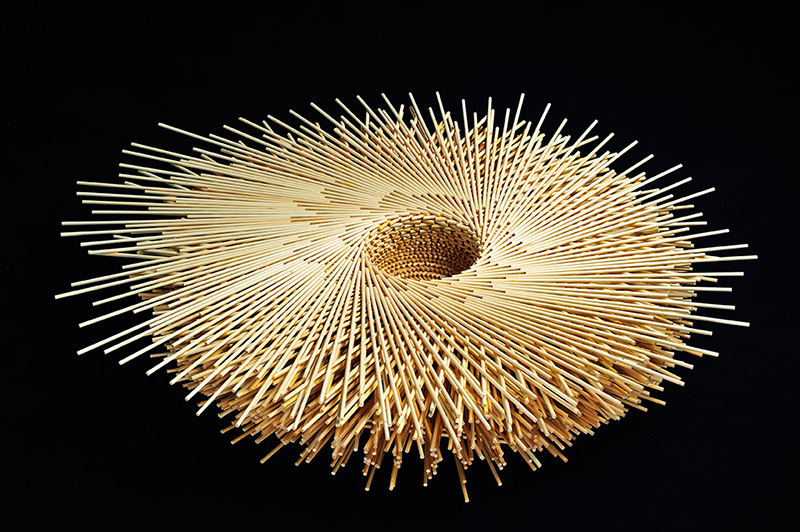
Photo: Mark Lindquist, Lindquist
Studio
Mark Lindquist Photographs at Lindquist Studio
- The Later Years
Mark has worked on many photographic projects over the years,
professionally, and for his own
fine art photographic pursuits. At this point, Lindquist
Studio is focused more on photography than
wood art, as Mark has aged and has had several health problems over
the years.
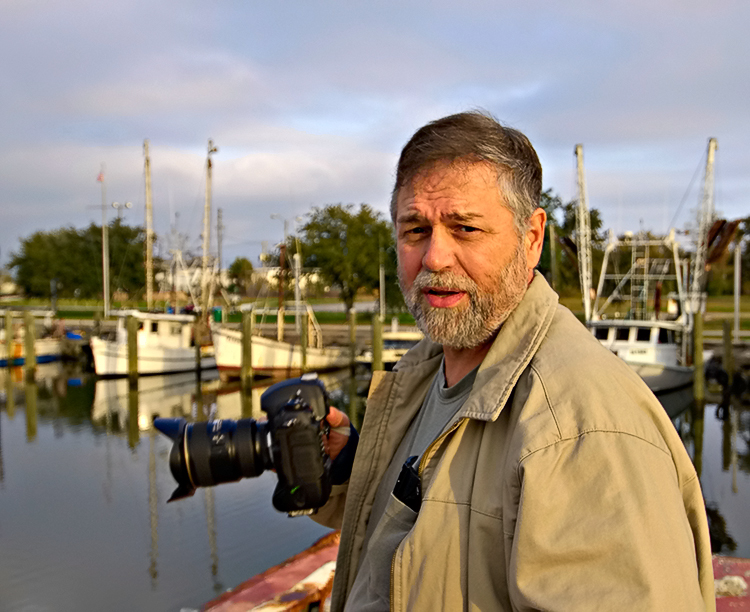
Lindquist photographing in Apalachicola, Florida |
Photo: J. McFadden
Mark Lindquist's Abstract
Photo Art
Mark began a series of photographic abstract art based on his
fascination with the images
resulting from winding to the end of a film roll while exposing the
film.
Once digital photography became equal to (or better than) the
quality of film, Lindquist began
a series of abstract photography based on motion blur.
He has continued to work in this direction for over ten years.
These images and more can be seen on robogravure.com
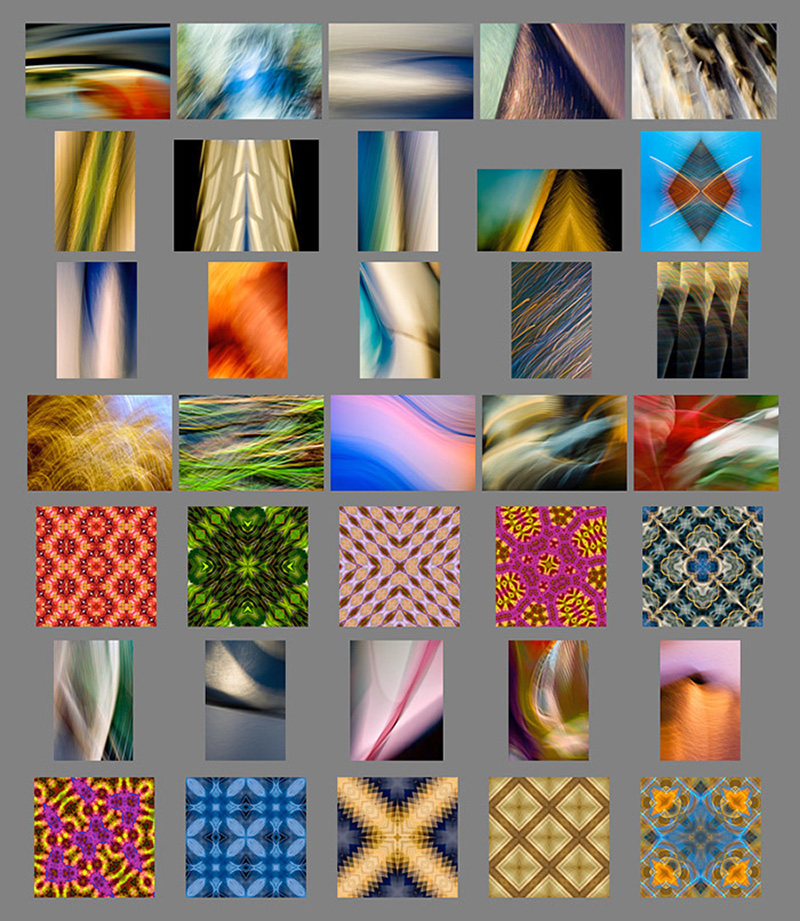
Examples of Mark Lindquist's abstract photography
- images from 2005- 2015
|





























































